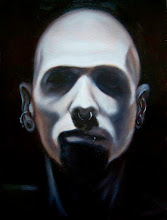exactly! I satisfied this urge!
The project I'm currently working on right now is a small oil-based clay Transi. A transi is a type of funerary monument which were most popular during the XVth and XVIth centuries, however examples of this type of monument started to appear during the XIVth century.
Unlike the popular gisant, which is a life-sized statue of the deceased in a peaceful, sleeping position, the transi presents the deceased as it truly is; A horrible, decomposing corpse, its skin tightly stretched over dry bones, in an eternal skeletal grin.
I absolutely ADORE this type of funerary monument, for it presents the true horror of death, without romanticizing it as with the gisants.
Of course, I'm not yet ready to do a full scale transi; my idea was to make a smallish sculpture, mold it, and cast candles from it. The symbolism of the body slowly melting and burning away as the candle burns goes hand to hand with what the traditional transis symbolizes.
To begin, I needed clay; I used the same type of clay with which I made my tsantsa, a cheap oil-based clay sold for 2$/pound. This type of clay won't dry, is very firm when cold, and softens as it heats up, making it perfect for detailed sculptures.
I use very few tools during the sculpting process; A small "ribbon" tool (I don't know the english name, but it's called a mirette in french), a knife, a wooden modelling tool (called an ébauchoir in french, I don't have any idea what it's called in english), a brush with alcohol to smoothen the clay, and a few toothpicks and needles.
I also fashioned a stand out of thick scraps of wood so I don't have to bend down as much while working on the sculpture.

Reference when doing anatomical work is also very important; During the sculpting process, I refer to the fifth edition of Gray's Anatomy. My copy is from 1870, but new editions are easy to find on ebay and amazon. However, I don't recommend this book if you're not familiar with human proportions, as it does not contain full-body illustrations.

As you can see, I'm also using a skull replica as a guide; the fact that it is in 3D makes it more practical.

Here's an example of what kind of illustrations you can expect to find in gray's anatomy. Although very detailed, only smallish parts of the human body are represented.
Once you've got all your tools, pictures, anatomical models and whatnot, you're ready to start!
Sculpting is like drawing; it's easier if you do a sketch first. There's no hurry to work on the details.


Here's a view of the front and back of my "sketch". The goal is to simply map out the pose, shape and proportions of the body. As you can see, I've left the head out. I personally prefer to work on the body first. There is also no legs nor arms; I'm not planning to add any, I only want a torso and a head.
Once this is done, you'll want to start working on the musculature; filling up some parts and removing clay from others to make it actually look like something. Knowing what to add and what to remove is a matter of practice, actually; most beginner sculptors will be afraid to remove too much clay, and end up with blocky results.

This, however, is a bit too skeletal for my tastes. I added small pieces of clay using my anatomy book as a guide to plump up the sculpture a bit.


Here, you have a shot of the back. Another common mistake is to work damn hard on the front without caring about the back, which can cause distortion and other problems in the finished product.

I've worked a bit more on the general shape of the body, and added a lump of clay on the neck so I can begin the head. Since the lump of clay I used for the head is still soft and warm from being kneaded, I let it cool down and harden a bit before working on the skull.

Here, you can see the skull slowly taking shape.
I still have a lot of work to do, but this still can give you an idea of what the finished product will look like.
I'll keep you updated when I finish the sculpture, with info on sculpting the details.



No comments:
Post a Comment